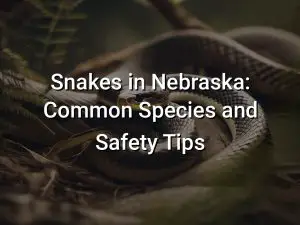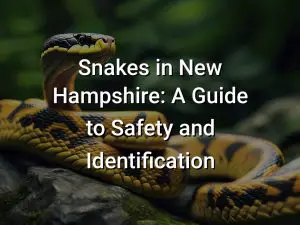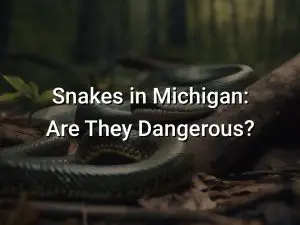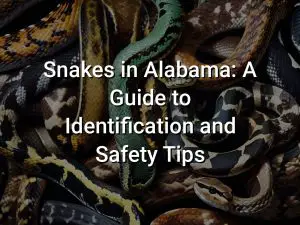Snakes in Utah: A Guide to the Local Species
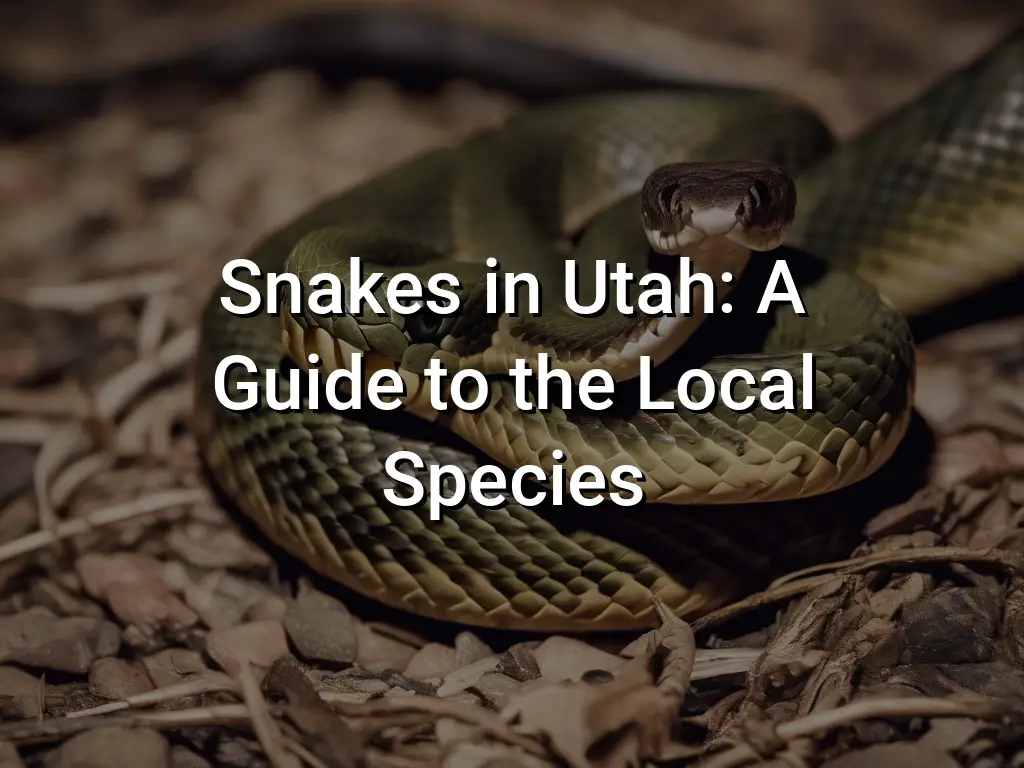
Utah, known for its stunning landscapes and diverse wildlife, is also home to a variety of snake species. From the beautiful Gopher Snake to the venomous Western Rattlesnake, these slithering creatures play an important role in the ecosystem of the state. In this guide, we’ll take a closer look at the local snake species found in Utah and their unique characteristics.
Whether you’re a snake enthusiast or simply curious about the wildlife in Utah, this guide will provide you with valuable insights into the different snake species that call the state home. Join us as we explore the fascinating world of snakes in Utah!
Quick Links
Gopher Snake
The Gopher Snake (Pituophis catenifer deserticola) is a non-venomous snake species commonly found in Utah. It is one of the largest snake species in the region, with adults reaching lengths of up to 7 feet.
Gopher Snakes are known for their distinctive coloration, which resembles the pattern of a rattlesnake. They have a yellow or light brown base color with dark brown or black blotches along their backs. This coloration serves as camouflage and helps them blend in with their surroundings.
These snakes are primarily found in arid and semi-arid habitats, such as deserts, grasslands, and shrublands. They are excellent burrowers and are often seen near rodent burrows, as they feed primarily on small mammals like mice, rats, and gophers. They are also known to eat birds, eggs, and reptiles.
Gopher Snakes are not dangerous to humans and will generally try to escape if encountered. However, they may hiss, vibrate their tails, and strike if they feel threatened. It’s important to keep a safe distance and avoid handling them to prevent any unnecessary stress or harm.
During the breeding season, which typically occurs in the spring, male Gopher Snakes will engage in combat to compete for females. Female Gopher Snakes lay eggs in underground chambers, and the young hatch after a couple of months.
If you encounter a Gopher Snake in Utah, remember to observe it from a safe distance and appreciate its role in the local ecosystem. These snakes play an important role in controlling rodent populations, and their presence is a sign of a healthy and balanced environment.
Great Basin Rattlesnake
The Great Basin Rattlesnake, also known as the Crotalus oreganus lutosus, is a venomous snake species found in Utah and other parts of the Western United States. It is one of the largest rattlesnake species in North America.
The Great Basin Rattlesnake is characterized by its stout body, triangular-shaped head, and distinct rattle at the end of its tail. Its coloration varies, but it typically has a brown or grayish-brown base color with dark brown blotches or bands along its body. The scales of the Great Basin Rattlesnake are keeled, which gives them a rough texture.
This species is primarily active during the warmer months, from spring to fall. It is most commonly found in rocky habitats, such as canyons, cliffs, and rocky slopes. The Great Basin Rattlesnake is also known to inhabit shrublands, grasslands, and sagebrush areas.
As a venomous snake, the Great Basin Rattlesnake possesses potent venom that it uses to immobilize its prey. It primarily feeds on small mammals, such as rodents, rabbits, and birds. Like other rattlesnake species, it uses its rattling tail as a warning signal when disturbed or threatened.
If you encounter a Great Basin Rattlesnake in the wild, it is important to give it a wide berth and not provoke it. While bites from this species are relatively rare, they can be dangerous and require immediate medical attention. It is always best to observe snakes from a safe distance and respect their role in the ecosystem.
Rubber Boa
The Rubber Boa (Charina bottae) is a non-venomous snake species found in Utah. It is a small snake, typically measuring between 14 and 33 inches in length. The Rubber Boa gets its name from its unique appearance and texture – its skin is smooth and feels rubbery to the touch.
This species can be identified by its light brown to reddish-brown coloration, with darker brown or black markings on its back. It has a short and blunt tail, giving it a stubby appearance. The Rubber Boa also has small eyes and a small head compared to its body.
Rubber Boas are primarily nocturnal and burrowers, spending much of their time underground or hiding in leaf litter. They are known to live in a variety of habitats, including forests, grasslands, and shrublands.
One interesting behavior of the Rubber Boa is its ability to curl up into a tight ball and tuck its head under its body when threatened, resembling a rubber toy. This defensive posture helps protect it from predators.
While the Rubber Boa is capable of biting if handled, it is generally considered docile and non-aggressive. Its diet mainly consists of small mammals, such as mice, voles, and shrews.
If you encounter a Rubber Boa in the wild, it is best to observe it from a distance and avoid handling it. Remember that all wildlife should be respected and left undisturbed in their natural habitat.
Common Garter Snake
The Common Garter Snake is one of the most widespread and commonly encountered snake species in Utah. They are non-venomous, making them harmless to humans, and are known for their distinctive color patterns.
Common Garter Snakes can vary in coloration, but they typically have a dark-colored body with three yellow stripes running down their back. These stripes may be more vibrant in some individuals, while others may have a more dull coloration.
These snakes are found in a variety of habitats, including meadows, forests, wetlands, and even urban areas. They are active during the day and are often seen basking in the sun or searching for food.
Common Garter Snakes feed primarily on small prey such as insects, amphibians, and small rodents. They use their keen sense of smell to locate their prey and catch them using quick strikes.
During the breeding season, male Common Garter Snakes will engage in courtship rituals to attract females. They will often form a breeding ball, where multiple males will try to mate with a single female.
Common Garter Snakes are beneficial to the environment, as they help control populations of pests such as rodents and insects. They are generally docile and will try to escape rather than defend themselves when threatened.
If you encounter a Common Garter Snake in Utah, it is best to observe it from a distance and not disturb or harm it. As with all wildlife, it is important to respect their natural habitat and not interfere with their behavior.
Hognose Snake
The Hognose Snake is a fascinating species found in Utah. They are known for their unique behavior and appearance. Hognose Snakes have an upturned snout, which gives them their name. They also have keeled scales and a stocky body.
- Habitat: Hognose Snakes can be found in a variety of habitats, including grasslands, deserts, and forests. They prefer areas with loose soil or sandy substrate where they can dig and burrow.
- Diet: These snakes primarily feed on toads, their favorite prey. They have specialized teeth that allow them to puncture toad skin and consume them. They also eat other small vertebrates, such as lizards and rodents.
- Defense Mechanisms: When threatened, Hognose Snakes have a unique defensive behavior. They may flatten their bodies, hiss loudly, and strike with their mouths closed. If this display fails to ward off the predator, they may also play dead by flipping onto their backs, opening their mouths, and even releasing a foul-smelling musk.
- Appearance: Hognose Snakes have a distinct color pattern that helps them blend into their surroundings. They are typically light brown or tan with dark blotches or speckles. Some individuals may have orange, red, or gray hues. Their bellies are usually lighter in color.
- Reproduction: Hognose Snakes are oviparous, meaning they lay eggs. Females will lay clutches of 10 to 25 eggs in sandy or gravelly soil. After an incubation period of around two months, the hatchlings emerge.
Overall, Hognose Snakes are an interesting and unique species found in Utah. They are known for their distinct appearance and playful defensive behaviors. If you spot a Hognose Snake in the wild, be sure to observe from a safe distance and appreciate their natural beauty.
Sonoran Whipsnake
The Sonoran Whipsnake (Coluber bilineatus) is a species of non-venomous snake found in the southwestern United States, including Utah. It is named for its long, slender body and its ability to move quickly and efficiently through its environment.
The Sonoran Whipsnake is typically found in desert and semi-arid regions, including rocky canyons, shrublands, and grasslands. It is a diurnal species, meaning it is active during the day. This snake feeds primarily on lizards and small mammals, using its speed and agility to capture its prey.
One of the distinguishing features of the Sonoran Whipsnake is its vibrant coloration. It has a yellow or light tan body with dark brown or black markings along its back and sides. Its belly is usually lighter in color, often white or cream. This coloration helps camouflage the snake in its arid habitat.
When threatened, the Sonoran Whipsnake may exhibit defensive behaviors such as hissing, vibrating its tail, or striking, but it is non-venomous and poses no significant danger to humans. It is important to remember that snakes play a vital role in the ecosystem by controlling populations of rodents and other small animals.
If you encounter a Sonoran Whipsnake in the wild, it is best to observe it from a safe distance and avoid disturbing or attempting to handle it. Appreciating these fascinating creatures from afar is the best way to ensure their protection and preservation.
Western Terrestrial Garter Snake
The Western Terrestrial Garter Snake, also known as Thamnophis elegans, is one of the most common snake species found in Utah. It is a non-venomous snake that belongs to the Colubridae family.
This snake species can be found in various habitats, including grasslands, forests, and wetlands. It prefers areas with a water source nearby, such as rivers, streams, or ponds.
The Western Terrestrial Garter Snake is known for its relatively small size, reaching an average length of 2 to 3 feet. It has a slender body with distinctive coloration. The snake’s base color can vary from olive green to brown or black, and it is adorned with a pattern of yellow or light-colored stripes along its body.
These snakes are active during the day and are often found basking in the sun or foraging for food. They have a varied diet, feeding on small prey such as insects, frogs, small fish, and even other snakes.
While the Western Terrestrial Garter Snake is generally docile and non-aggressive, it can become defensive if threatened or handled. It may release a foul-smelling musk or bite if it feels threatened. However, their bites are harmless to humans and rarely break the skin.
In Utah, the Western Terrestrial Garter Snake plays an important role in maintaining the balance of ecosystems. They help control populations of pests and serve as a food source for larger predators.
It’s important to appreciate and respect the natural habitats of these snakes and avoid disturbing them in their natural environment. If you encounter a Western Terrestrial Garter Snake, observe from a distance and allow it to continue its activities undisturbed.
Western Rattlesnake
The Western Rattlesnake is a venomous snake species that is found in various regions of Utah. It is a pit viper, characterized by the heat-sensing pits located between its eyes and nostrils. This species is known for its distinctive rattle, which it uses as a warning signal when it feels threatened.
The Western Rattlesnake can vary in coloration, but is typically gray or brown with dark blotches or bands along its body. It has a triangular-shaped head and keeled scales. Adult Western Rattlesnakes can reach lengths of up to 4 feet.
These rattlesnakes are typically found in desert habitats, but can also be found in grasslands, forests, and rocky areas. They are ambush predators, using their camouflage to lay in wait for prey. Their diet mainly consists of small mammals, such as mice, rats, and rabbits.
If encountered, it is important to give the Western Rattlesnake a wide berth and not provoke or approach it. Their venom is potent and can cause serious health issues or even death. If bitten by a Western Rattlesnake, seek immediate medical attention.
It is illegal to harm or kill rattlesnakes in Utah, as they play an important role in the ecosystem by controlling rodent populations. If a Western Rattlesnake is found in your yard or property, contact a professional snake removal service to safely relocate the snake.
Remember to always be cautious and aware of your surroundings when exploring snake habitats in Utah to ensure a safe and enjoyable experience.
Western Yellow-bellied Racer
The Western Yellow-bellied Racer is a snake species that can be found in Utah. It is a nonvenomous snake that belongs to the Colubridae family. As its name suggests, the Western Yellow-bellied Racer has a yellow belly, which contrasts with its dark brown or greenish upper body.
This snake has a slender and elongated body, allowing it to move quickly. It can reach lengths of up to 3-4 feet. The Western Yellow-bellied Racer is known for its speed and agility, making it an adept hunter of small vertebrates, such as lizards and rodents.
When threatened, the Western Yellow-bellied Racer may exhibit defensive behaviors, including vibrating its tail, coiling, or even striking. However, it is important to note that this snake is nonvenomous and poses no significant danger to humans. It is best to appreciate and observe this snake from a safe distance.
The Western Yellow-bellied Racer can be found in a variety of habitats, including open woodlands, grasslands, and shrubby areas. It is most active during the warmer months, as it relies on external sources of heat to regulate its body temperature.
As with all wildlife, it is important to respect the Western Yellow-bellied Racer and its natural habitat. Avoid handling or disturbing this snake if you encounter it in the wild, as this can cause stress and potentially harm the snake. By appreciating these unique reptiles from a distance, you can contribute to their conservation and the overall biodiversity of Utah’s ecosystems.
Long-nosed Snake
The Long-nosed Snake is a species of snake found in Utah and other parts of the southwestern United States. It is known for its distinct appearance, with a slender body and a long, pointed nose. The coloration of the Long-nosed Snake can vary, but it typically has a reddish-brown or tan body with dark brown or black markings.
Long-nosed Snakes are primarily nocturnal and are most active during the cooler hours of the evening and night. They are secretive snakes, often hiding under rocks, in crevices, or in underground burrows during the day. They are primarily ground-dwelling snakes but are also capable climbers.
This snake primarily feeds on small rodents, lizards, and bird eggs. It uses its sharp teeth and constriction to catch and subdue its prey. Long-nosed Snakes are not venomous and pose no threat to humans. However, if threatened, they may bluff-strike or release a pungent odor as a defense mechanism.
The Long-nosed Snake is a unique and fascinating species that plays an important role in the ecosystems of Utah. While encounters with this snake are relatively rare, it is always important to respect their habitat and appreciate their beauty from a safe distance.
Conclusion
Utah is home to a diverse range of snake species, each with its own unique characteristics and behaviors. By understanding more about these snakes, you can better appreciate and coexist with them in their natural habitats.
Remember, if you encounter a snake in the wild, it’s important to maintain a safe distance and avoid disturbing or provoking them. Snakes play an important role in our ecosystems, and by respecting their space, we can ensure a harmonious coexistence.

